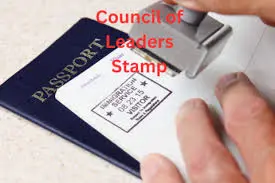Symbols have traditionally played an important role in forming impressions and conveying authority. From ancient seals to modern logos, these graphic symbols express power, trust, and solidarity. One such noteworthy emblem is the “Council of Leaders Stamp.” This emblem is more than a mark; it reflects a governing body’s combined strength and cohesive leadership. In this article, we will look at the Council of Leaders stamp’s history, meaning, and impact, demonstrating how it remains a potent symbol of authority and togetherness.
Historical Background of Leadership Councils
The Early Foundations of Leadership Councils
Leadership councils have existed in various forms throughout history, frequently in response to the necessity for organized governance. In ancient societies, tribe elders or community leaders would meet to discuss and make decisions on behalf of the entire group. These early councils paved the way for more formalized forms of leadership, emphasizing collaboration and group decision-making.
The Role of Councils in Ancient Civilizations
Ancient civilizations such as Greece, Rome, and China established organized leadership councils. In ancient Greece, the Boule was a council of citizens who assisted in the administration of the city-state. Similarly, Rome had the Senate, which was vital to the Roman Republic’s rule. These councils served as a forum for discussion, debate, and decision-making, ensuring that all viewpoints were considered before any action was taken.
Medieval and Renaissance Councils
During the medieval period, leadership councils grew more structured, particularly within kingdoms and empires. Kings frequently relied on councils of nobility, clergy, and counselors to help manage their domains. The Magna Carta, signed in 1215, was a watershed point in history, establishing the concept that even monarchs were subject to the law and that a council could represent the people’s interests.
The Origins of the Council of Leaders Stamp
Ancient Beginnings: Seals as Symbols of Authority
The idea of a stamp or seal goes back thousands of years. Ancient civilizations such as the Egyptians and Mesopotamians employed seals to authenticate documents and indicate acceptance. These seals, which were frequently made of stone or metal, featured complex designs that signified the strength and legitimacy of their leaders. The use of seals as a badge of authority persisted through the ages, growing into more intricate and sophisticated forms.
The Birth of the Council of Leaders Stamp
The origins of the Council of Leaders stamp can be traced back to the early days of organized administration. As societies expanded, so did the demand for formal leadership. Councils were founded to reflect leaders’ combined wisdom, necessitating the creation of a unified symbol. The Council stamp arose as a distinctive logo, representing the combined strength and authority. It functioned as a visible record of their choices, guaranteeing that all actions carried out under its banner were valid and acknowledged.
The Symbolism Behind the Council of Leaders Stamp
Representing Unity and Cohesion
The Council of Leaders is more than just a symbol of authority; it represents solidarity. It symbolizes the idea that various leaders, each with their own viewpoints and strengths, may work together to make collective decisions for the common good. The stamp is thus a visual representation of collaboration and cooperation, emphasizing the power of collective leadership.
A Mark of Legitimacy and Trust
In any organization, trust is critical. The Council of Leaders stamp is a guarantee of legitimacy, indicating that all decisions and papers it endorses have been thoroughly scrutinized and authorized by the This symbol of confidence ensures the public and other stakeholders that the leadership is accountable, credible, and in line with the organization’s beliefs and objectives.
The Impact of the Council of Leaders Stamp in Governance
Ensuring Accountability and Transparency
One of the key roles of the Council of Leaders is to promote accountability. By placing their stamp on decisions and documents, council members take collective responsibility for their actions. This accountability ensures that leaders remain transparent and answerable to their constituents. The stamp, therefore, acts as a safeguard against unilateral decisions and fosters a culture of openness and responsibility.
Strengthening Leadership and Authority
The Council of Leaders stamp also reinforces the authority of the leadership. By using a unified symbol, the council demonstrates its collective strength and resolve. This consolidation of power helps to establish the council as a formidable force, capable of making tough decisions and guiding the organization or community toward its goals. The stamp, thus, becomes a rallying point, inspiring confidence and respect among followers.
The Future of the Council of Leaders Stamp
Embracing Change While Preserving Tradition
As we progress into the digital age, the Council of Leader will evolve. However, its core concepts will stay unchanged. Leaders will always require symbols to demonstrate their power, unite their people, and build trust. The issue is to embrace change while maintaining the traditions and principles that the Council of Leaders stamp represents.
The Continued Importance of Symbolism in Leadership
The Council of Leaders stamp reminds us that symbolism plays a crucial role in leadership. It transcends mere visual representation, embodying the ideals and values of a group. As leaders continue to navigate the complexities of modern governance, the importance of symbols like the Council of Leaders stamp cannot be underestimated. They serve as a constant reminder of the power of unity, the need for accountability, and the strength that comes from collective leadership.
Conclusion
The Council of Leaders stamp demonstrates the enduring importance of symbols in leadership. From its ancient origins to its current variations, it has represented authority, unity, and trust. As leaders face future difficulties, the Council of Leaders Stamp’s values will serve as a guiding force, reminding us that effective leadership is based on collaboration, integrity, and a commitment to the greater good.
FAQS
The Council of Leaders Stamps are symbolic marks that reflect the authority and unity of a leadership council. It represents communal decision-making and is used to verify official documents and decisions.
It is significant because it signifies the trust, legitimacy, and collective authority of a leadership group. It guarantees that decisions are clear and responsible.
The stamp has evolved from physical seals used in ancient civilizations to modern digital seals. While the form has changed, its role as a symbol of unity and authority remains constant.
The stamp symbolizes unity, authority, and trust. It reflects the collaboration and collective strength of a leadership council.
Yes, the Council of Leaders stamp remains relevant. It continues to symbolize the principles of unity and legitimacy, essential in both traditional and modern leadership structures.




